Jews and the Shiksa II: Dustin Hoffman
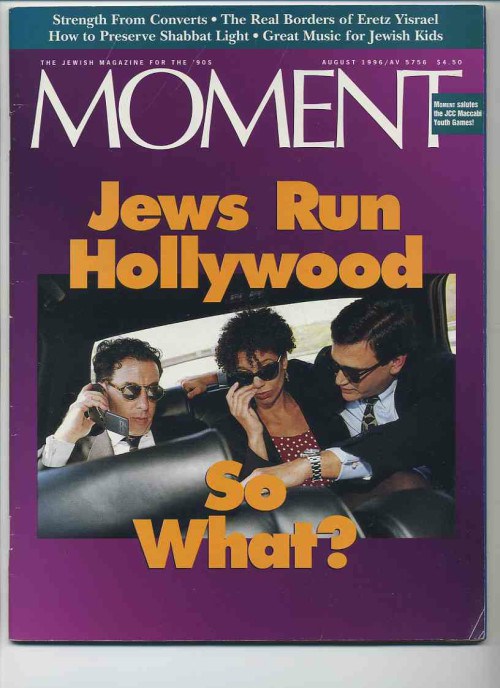
From its origins, Hollywood has been stamped with a Jewish identity, but nobody else was supposed to know about it. But somehow, no matter how thorough the attempt to suppress or disguise it, Jewishness is going to bob to the surface anyway.
Stephen J. Whitfield
In what I hope to be a short series of essays on Jewish Hollywood, I wish to focus primarily on the topic of the shiksa, as I did recently in Harvey Weinstein: On Jews and the Shiksa. A larger issue, however, will be to show why it matters that Jews control Hollywood. That is the reason I have used the valuable Moment Magazine cover photo (above) time and again in my blogging, for it is an admission of something critical to American (and world) history: “Jews Run Hollywood.”
Of course that is no secret to the vast majority of TOO readers, so it is the subtitle that really interests me: “So What?” I confess I am put on the defensive about this question. It has always been clear to me why it matters, at least once you realize that Jews do in fact run Hollywood. Yet, as incredible as it seems, the heavy majority of those I get to agree that Jews do indeed run Hollywood respond with that maddening phrase “So What?” In my view, this is mental self-policing at its worst. So, as has been the case in all my Hollywood writing, my aim is to explain (to the normie, perhaps) why it matters who controls a medium as powerful as Hollywood has been for a century.
In the Harvey Weinstein blog, I argued that aggressive hostility is a large component of the Jewish male domination of Gentile females (shiksas). Right on cue, TOO editor Kevin MacDonald followed up with a powerful exegesis of the phenomenon in his essay Harvey Weinstein: Revenge and Domination as Jewish Motives. Here he wrote that “The hatred is real and is intimately tied in with sexual competition” and also quoted from his review of Yuri Slezkine’s book The Jewish Century:
The amorous advances of the Jewish protagonist of Eduard Bagritsky’s poem “February” are rebuffed by a Russian girl, but their positions are changed after the Revolution when he becomes a deputy commissar. Seeing the girl in a brothel, he has sex with her without taking off his boots, his gun, or his trench coat—an act of aggression and revenge:
I am taking you because so timid
Have I always been, and to take vengeance
For the shame of my exiled forefathers
And the twitter of an unknown fledgling!
I am taking you to wreak my vengeance
On the world I could not get away from!
The passage is stunning, yet my experience has shown that almost no non-Jew I’ve talked to has any idea about this hostility, let alone how it appears in Hollywood fare. Why is that?
In short, I would argue, it is an aspect of parasitism in which the parasite must somehow deceive the host, for were the host to understand its loss (and possible impending death), it would resist the parasite. To the extent that Jews act as parasites, they must have strategies that prevent the host from realizing what is happening. Since Hollywood is such a damaging form of assault on traditional White society, viewers of poisonous Tinseltown films must not notice how Jewish Hollywood is nor can they ever imagine that Jews might be harmful.
And that’s why Jews push the image of the Jew-as-schlemiel, the definition of which is:
“an awkward, clumsy person,” 1868, from Yiddish shlemiel “bungler; a stupid person; fool; oaf; esp, a naive person often victimized; an awkward or unlucky person whose endeavors usually fail
This is also related to the character known as a nebbish, someone who is “a pitifully ineffectual, luckless, and timid person.” Jews have used these characters to great effect in creating the illusion that they are harmless.
One of the greatest purveyors of this image is of course Woody Allen, someone who seems to perfectly embody the schlemiel or nebbish. Here he is in Sleeper (1973):
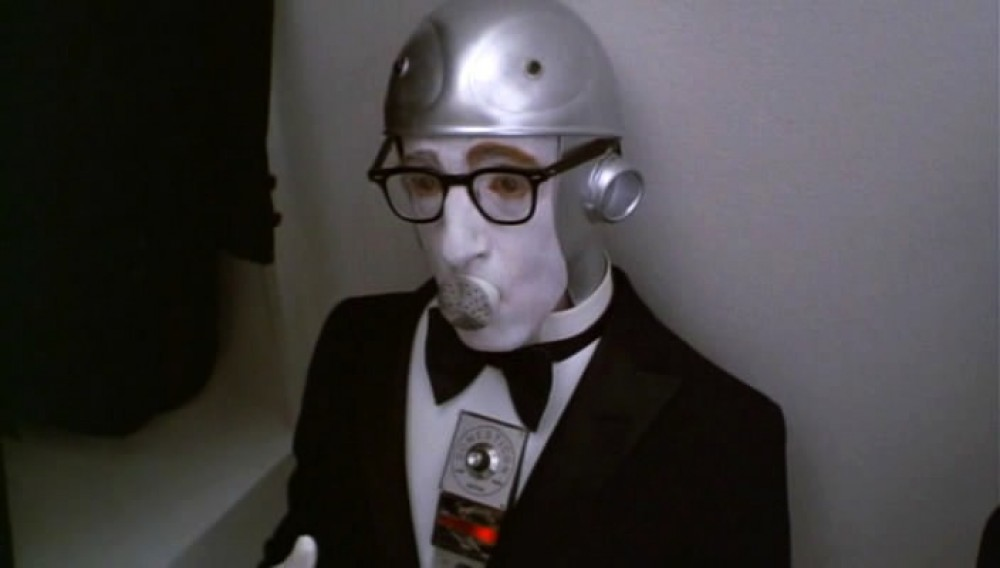
Harmless, right?
While Hollywood certainly has its share of nebbishy Jewish characters (Richard Dreyfuss in Down and Out In Beverly Hills, Albert Brooks in The Muse, and many of Dustin Hoffman’s characters, which I’ll discuss later), for many Americans, TV portrayals provide a richer trove of these lovable losers. Think, for instance, of Maxwell Smart, played by (half-Jewish) Don Adams in the hit series “Get Smart”:
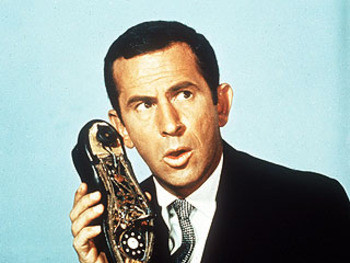
The series was created by Jewish talents Mel Brooks and Buck Henry and was full of Jewish humor. Or think about “The Odd Couple,” with Jewish actors Jack Klugman and Tony Randall. Randall’s Felix Unger was a classic schlemiel.
Moving to more recent history, the “Seinfeld” cast was built on nebbishy people, particularly George Costanza who, although not explicitly presented as Jewish in the show, is a classic Jewish type, played by the Jewish actor Jason Alexander. In a later series, Larry David plays the schlemiel to the hilt in “Curb Your Enthusiasm,” though careful viewers will often find veiled aggressiveness toward goyim in many scenes.
The point of all this is that these characters, while certainly finding counterparts among Jews in real life, still reinforce the stereotype of Jewish men as funny, harmless, lovable losers, which completely whitewashes the reality of many incredibly harmful Jews who wield power in our world.
Consider, for instance, the Red Terror in Russia, where some expressed shock that seemingly pacifistic Jews (p.85) changed almost overnight. “We were amazed by what we had least expected to encounter among the Jews: cruelty, sadism, and violence had seemed alien to a nation so far removed from physical, warlike activity; those who yesterday did not know how to use a gun are now found among the executioners and cutthroats.”
In another instance, a “formerly oppressed lover of liberty had turned into a tyrant of ‘unheard-of despotic arbitrariness.’” He had been “transformed outwardly into a leather-clad person with a revolver and, in fact, lost all human likeness.” He could now be pictured as “standing in a Cheka basement doing ‘bloody but honorable revolutionary work.’”
We now know that such Jews were responsible for tens of millions of White Christian deaths, but of course we rarely if ever see such images on screens big or small. Instead, we have Woody Allen, Jerry Seinfeld, and Dustin Hoffman, to whom I now turn.
Dustin Hoffman
In my previous essay linked above I noted that in the film Lenny (1974), where Jewish actor Dustin Hoffman stars as renegade comedian Lenny Bruce, “we see the quintessential shiksa lust scene: Bruce bursts into a room, intent on meeting his blonde girlfriend, and is stunned to see her posing naked for him. Transfixed, he quivers and intones, ‘Oh yeah. Oh yeah. It’s a shiksa goddess.’” That was fitting in that Hoffman often appears as a Jew — though masked to varying degrees — who has intimate involvement with the shiksa. This was crystal clear to me when I watched The Graduate. It’s also fitting that Hoffman has been accused of sexual harassment of a then 17-year old girl in 1985.
The Graduate (1967) was directed by Jewish Mike Nichols, an immigrant from Danzig. Buck Henry (born Henry Zuckerman in NYC) was one of two screenwriters for the film. Hoffman, of course, stars as recent college graduate Benjamin Braddock, an aimless young man. The shiksa theme in the film is obvious, as Ben enters into an adulterous affair with the married Mrs. Robinson. (Later, he dates Mrs. Robinson’s daughter Elaine.) Mrs. Robinson is portrayed as part of a large upper-middle class goyish circle in Pasadena, California — I think readers can see where this is going.
Jumping to the climax of the movie, we have the church scene, where Ben races to the church to break up Elaine’s impending marriage to a blond goy. This is the scene in which Cuddihy (The Ordeal of Civility) meets Roth (Portnoy’s Complaint). One really must see it to realize how brazenly it shows a Jew defeating the hated Gentile civilization. To begin with, the setting is the most Gentile of all settings: a beautiful Christian church, complete with minister, organ and well-dressed people.
Ben, however, has no respect for this goy setting. He climbs into the second-floor choir loft, pounds on the glass barrier, then screams out the shiksa’s name: “Elaine! Elaine!” In the Jewish fantasy that the scene represents, Elaine realizes that Ben is the better choice of a man and she abandons both altar and new (goy) husband to be with Ben. But now comes the battle between civilizations. This scene plays out the Revenge and Domination motif that MacDonald discusses, such as that displayed by Sigmund Freud when he fantasized about destroying Christian Rome.
Here in a Santa Barbara church, the Christian men respond to Ben’s incivility, with the cuckolded Mr. Robinson rushing up the stairs to confront Ben. This dextrous Jew, however, leaps over the railing, then deftly elbows Mr. Robinson in the ribs, taking him out of the fray. Next, Ben charges the young blond men and gray-haired gentlemen who rise to stop him.; Ben knocks them all back. Then, he grabs a gold cross and begins using it as a weapon to keep these seething goyim at bay.
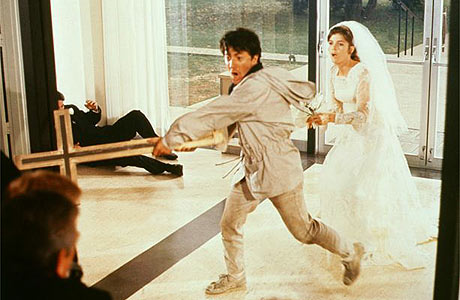
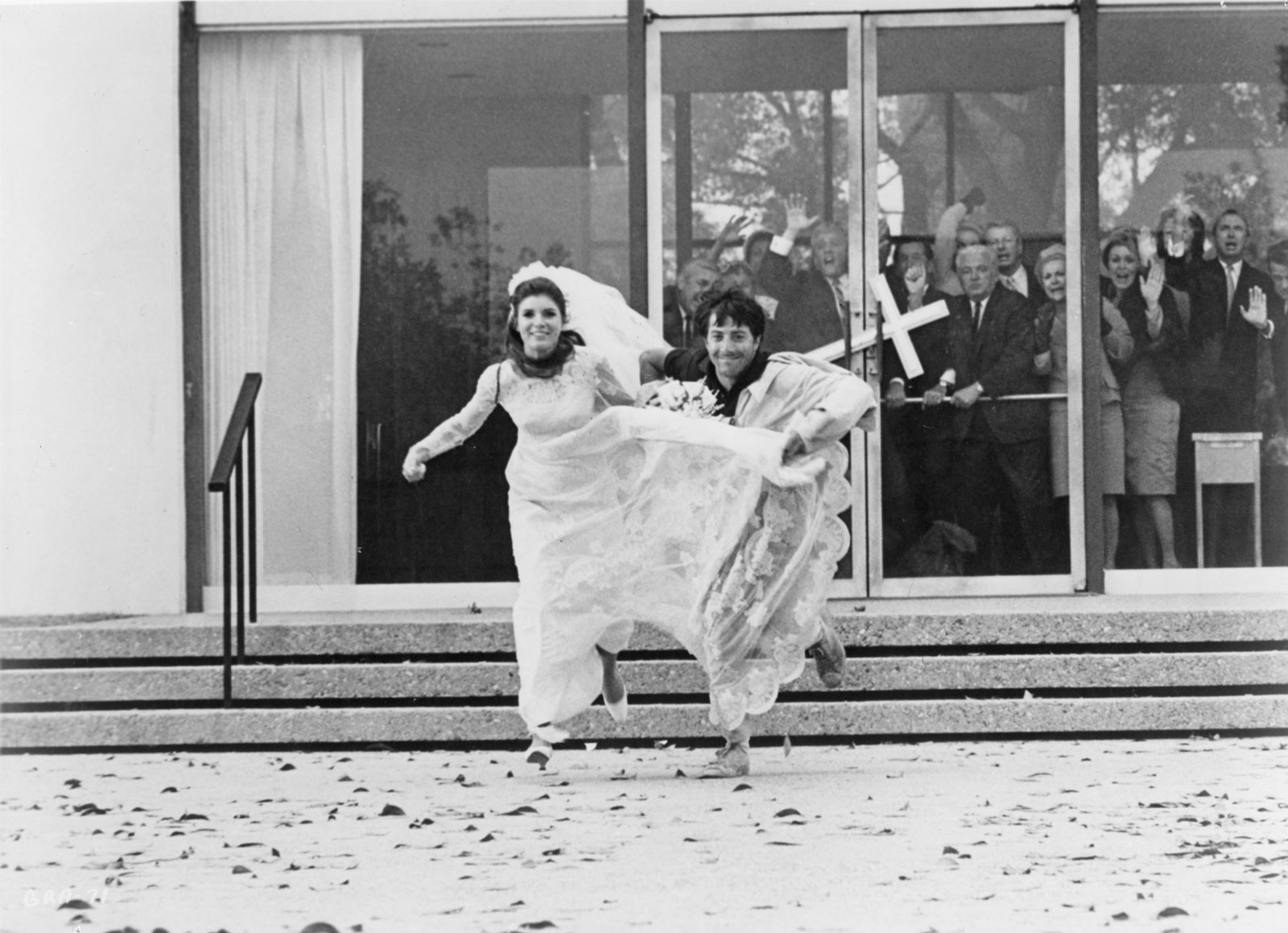
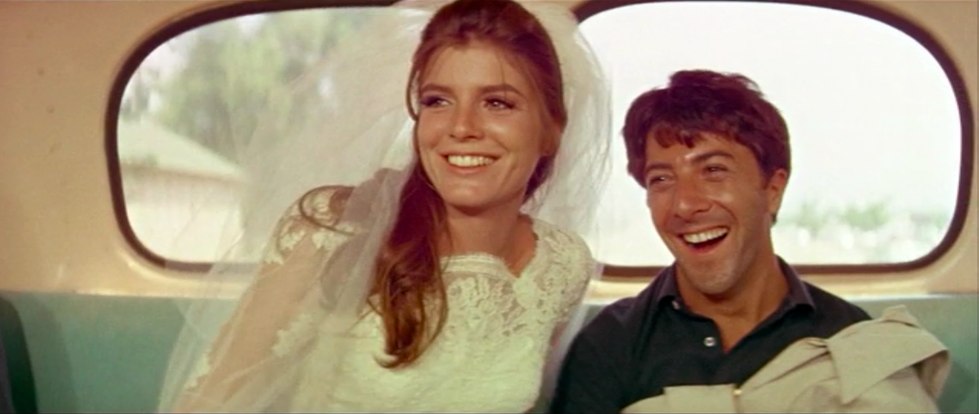
“Hating Your Goy and Eating One Too”
The Graduate could have been fodder for Philip Roth as he composed his novel Portnoy’s Complaint. In the film, Ben succeeds in sleeping with both mother and daughter from a Gentile family, while in the novel Roth describes how Portnoy, filled with shiksa lust, confesses to his psychiatrist, “What I’m saying, Doctor, is that I don’t seem to stick my dick up these girls, as much as I stick it up their backgrounds — as though through fucking I will discover America. Conquer American — maybe that’s more like it.”
Yeah, Jews run Hollywood. Now you have one answer to the “So What?” of that equation.
And if you’re curious about more Dustin Hoffman films with Jewish themes, please consider Marathon Man (1976). Though it lacks the shiksa theme, it is an overtly Jew vs. German film, with World War II featuring strongly in the story. In this film, Hoffman plays an explicitly Jewish character (Babe Levy) who encounters one Christian Szell, “a character clearly modeled on [Nazi sadist, Doctor Josef] Mengele.” Likely many readers remember the scene in which Szell, desirous of getting diamonds stolen from murdered Jews, resorts to torturing Babe by drilling sensitive points in his teeth without the use of anesthesia. Of course Babe Levy prevails in the end. This is Hollywood, after all.
A few years later, Hoffman starred in Kramer vs. Kramer (1979) with Meryl Streep playing his unhappy wife. In this film, as many might remember, the relationship between the seemingly Jewish man and his seemingly non-Jewish wife is strained to the point that the wife leaves the family.
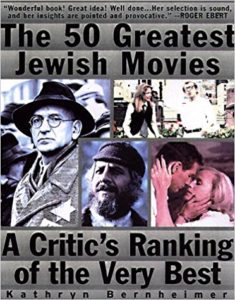 In Outbreak (1995), however, we have the shiksa theme, as Hoffman’s character has a stunning blonde wife played by Rene Russo. This Walter Mittyesque fantasy film imagines that little Dustin Hoffman can save society from a mad military man bent on controlling America through biological warfare. Believe it or not, this trope of Jews saving others is so common that film expert Kathryn Bernheimer dubs this category “Jews to the Rescue.”
In Outbreak (1995), however, we have the shiksa theme, as Hoffman’s character has a stunning blonde wife played by Rene Russo. This Walter Mittyesque fantasy film imagines that little Dustin Hoffman can save society from a mad military man bent on controlling America through biological warfare. Believe it or not, this trope of Jews saving others is so common that film expert Kathryn Bernheimer dubs this category “Jews to the Rescue.”
Of course the bad guys are White military men who plan to blow up a small town full of Americans, with the general chillingly portrayed by Donald Sutherland, with white hair and piercing blue eyes, playing the Aryan bad guy. Helping the heroic Jew are some good Blacks, played by Cuba Gooding, Jr. and “Numinous Negro” Morgan Freeman, who gets to arrest the White general. In the end, Hoffman’s character finds the cure for the lethal “outbreak” and saves his dying shiksa wife’s life.
You can make these movies when you run Hollywood.
Conclusion
This essay started with a quote from Jewish culture expert Stephen J. Whitfield, so it is fitting that I end with another of his thoughts. Since the heavy Jewish presence in Hollywood has been a constant for over a century, it is no surprise that Jewry has “left its skid marks. For American Jews have exerted an extraordinary impact upon the character of the United States.”
Unfortunately, that is so.





Comments are closed.